
Emmert No. 1 Type Study

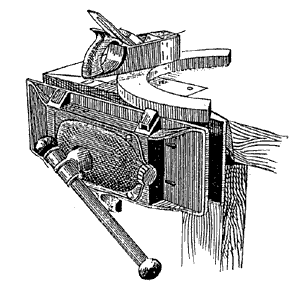
The purpose of this Type Study is to describe the subtle
variations and differences in the Emmert patternmaker's
vise. While the Emmert Mfg. Co. produced a number of fine well crafted work holding
devices, the type study described here is limited to the large and handsome No. 1
Patternmakers vise or Universal vise. The smaller yet very capable No. 2 model is similar and can be seen on
the Small Emmert Photos page. Other models such as
the Machinist No. 4a and 6a can be seen on the
Other Emmert Vises page.
The Emmert patternmakers vise has the ability to hold the work piece and
then rotate on the axis of the screw or hub. This finely crafted vise can
also tilt the work piece upright using its unique hinge mounting angle so
that the work piece is held parallel to the top of the bench. The tilt action is locked in place by the tilt
adjustment lever
and tilt lever bracket. These parts mount to the underside of the bench or
to the bench leg. Often the tilt adjustment lever and tilt bracket are missing
when purchasing an Emmert vise having been left behind when removing. Also these parts are often mismatched with
other Emmerts or Yost parts as they are replace with what ever is available.
The Tilt Adjustment are described in a separate section.
The No. 1 cast iron vise weighs a massive 86 lbs and has 7" x 18" jaws which open 14
inches.
The Numbering System. Emmert patternmaker's vises fall in two main categories. They are commonly called
the Turtleback and the K1 or "New Improved" Universal vise. For
years both of these main types were sold at the same time. Both were called
No. 1 Universal Vises. So to avoid confusion, the numbering system is divided between
T for Turtleback
and U for the "new improved" Universal. I did not want to use the "K" in the type
numbering since that would be confused with the "K" in the casting numbers.
See Emmert Anatomy for more information on the casting
numbers. I considered using dates in the numbering system. Finding dates of
manufacture proved to be too difficult. I could not find anyone to sell or
loan me an Emmert Catalog. Other tool catalogs often did not match the
products being sold. For instance, one ad in a
1913 tool catalog shows a
Turtleback with one patent date. The second patent was approved in April
1905 (6 years earlier). For these reasons, I have chosen to use a linear
numbering system. If additional types are found, I (and I hope those who
come after me) will add a decimal point and number after the original
numbers. This will allow the original Type U3 to remain after the Type U1.5
or Type U0.5 is uncovered.
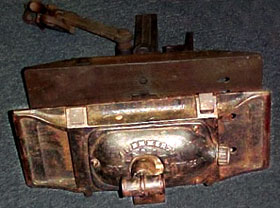 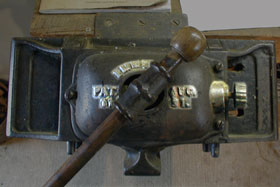
|

Turtleback Types

The Turtleback name comes from the shape of the
cover on the front jaw. Click on the picture to see additional photos of
that type. Move cursor over the picture to highlight features. |
Type T1
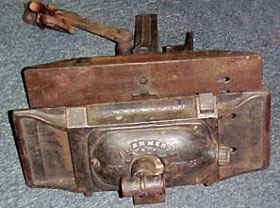
Turtleback with One patent date, geared symbol
around spindle hole, no text on front jaw.
Cover has a gear symbol around spindle hole,
and J. F.
Emmert's arched on above, Pat. Aug. 11 in middle and 1891 Waynesboro PA. on
below (Logo1). Cover gently sweeps towards taper adjustment. 3 round head slotted
machine bolts
hold the cover on.
Front Jaw does not have a casting number or
text.
Rear Jaw
Vise Dogs 4 dogs, 2 flat top on rear jaw and 2 angled top on front
jaw. They are made of cast iron and break easily.
Taper Adjustment is round knob with short stem.
Hub has a casting number of 14 (Hub1).
Beam has slot on side.
Mounting Angle
Tilt Adj. Mechanism is flat bar with notches
(TA1).
The vise will rotate 360 degrees and lock in 45 deg.
increments.
Type T1 may have a serial number stamped on it.
Click Here.
This is a uncommon type.
Type T1 Photos

|
Type T2
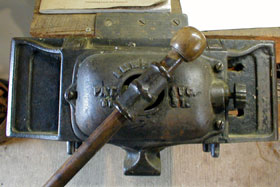
Turtleback with One patent date, no gear symbol, no
text on front jaw.
All the features of Type T1 except as noted below...
Cover has Emmert's arched over spindle hole,
and Pat. Aug. 11 91 (Logo2). Cover is more rounded at taper adjustment.
Front Jaw has no casting number or text.
Rear Jaw
Vise Dogs 4 dogs.
Taper Adjustment is round knob with short stem.
Hub has a casting number of 14 (Hub1).
Beam has slot on right side.
Mounting Angle
Tilt Adj. Mechanism is a round bar (TA2).
Type T2 probably has a serial number stamped on it.
Click Here.
Type T2 Photos

|
Type T3
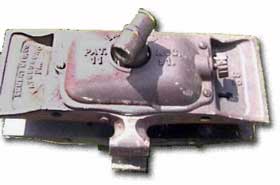
Turtleback with One patent date, no gear symbol,
front jaw has 82 on right and usual Emmert text on left.
Cover is same as T2 (Logo2).
Front Jaw has 82 casting number on right side and Emmert Mfg.
Co. Waynesboro (arched) PA. USA on left side (Logo4).
Rear Jaw
Vise Dogs 4 dogs.
Taper Adjustment is round knob with a short stem.
Hub has a casting number of 14 (Hub1).
Beam has slot on right side.
Mounting Angle
Tilt Adj. Mechanism is a round bar (TA2).
Type T3 probably has a serial number stamped on it.
Click Here.
This is an uncommon type.
Type T3 Photos

|
Type T3.2
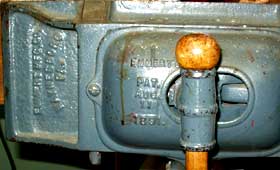
Turtleback with One patent date, elongated spindle
hole, front jaw has 82 on right and usual Emmert text on left.
All the features of Type T3 except as noted below...
Cover has Emmert's straight over spindle hole,
and Pat. Aug. 11 1891 (Logo3). Spindle hole
is oval shaped and much larger like the Type T4. This allows the cover to be
removed without removing the spindle.
Front Jaw has 82 (horizontal or vertical or
under the cover) or 2 casting number on right side and Emmert Mfg.
Co. Waynesboro (arched) PA.USA (Logo4) or
without USA (Logo3.7) on the left side.
Rear Jaw
Vise Dogs 4 dogs.
Taper Adjustment is round knob with short or long stem.
Hub has a casting number of 14 (Hub1).
Beam has slot on right side.
Mounting Angle
Tilt Adj. Mechanism is a round bar (TA2).
Type T3.2 Photos

|
Type T3.5
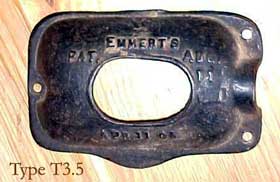
Turtleback with Two patent dates but 1891 scratched
off, elongated spindle hole, front jaw has 82 on right and usual Emmert text
on left.
All the features of Type T3 except as noted below...
Cover has Emmert's straight (not arched) over spindle hole,
and Pat. Aug. 11 (Logo3.5). Spindle hole is
oval shaped and much larger like the Type T4. This allows the cover to be
removed without removing the spindle. Below the spindle hole reads Apr. 11 05.
Front Jaw
Rear Jaw
Vise Dogs 4 dogs.
Taper Adjustment is round knob with short or long stem.
Hub has a casting number of 14 (Hub1).
Beam has slot on right side.
Mounting Angle
Tilt Adj. Mechanism is a round bar (TA2).
I gave this one a separate Type number because the
cover is one of the main distinguishing elements. This cover might be an odd
and unusual casting. It appears that the 1891 was scratched prior to casting
the part.
Type T3.5 Photos

|
Type T4
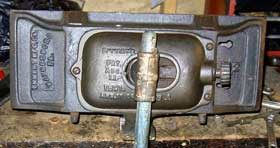
Turtleback with Two patent dates, elongated spindle
hole, front jaw has 82 on right and usual Emmert text on left.
Cover has two Patent dates (Pat. Aug 11, 1891 &
Apr. 11, '05) and says Emmert's above and USA below (Logo3).
Spindle hole is oval shaped.
Front Jaw has 82 (horizontal or vertical or
under the cover) or 2 casting number on right side and Emmert Mfg.
Co. Waynesboro (arched) PA.USA (Logo4) or
without USA (Logo3.7) on the left side.
Rear Jaw
Vise Dogs 4 dogs, very delicate.
Taper Adjustment is round knob with short or long stem.
Hub has a casting number of 14 (Hub1).
Beam
Mounting Angle
Tilt Adj. Mechanism is a round bar (TA2).
Type T4 Photos

|
Type T5
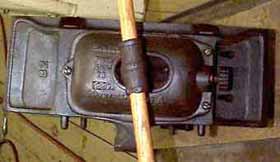
Turtleback with Two patent dates, elongated spindle
hole, front jaw has 82 on left side now with nothing on right.
Cover is same as Type T4 (Logo3).
Front Jaw has casting number 82 on left side.
Rear Jaw has casting number 13 on left side
Vise Dogs 4 dogs.
Taper Adjustment is round knob with long stem (usually).
Hub has a casting number of 14 (Hub1).
Beam has slot on right side.
Mounting Angle
Tilt Adj. Mechanism is a round bar (TA2).
Type T5 Photos

|
|

K1 Types or
New Improved
Universal

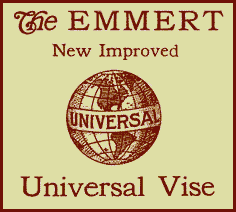
The "New Improved" Universal types are sometimes called "K1"
because of the casting number on the front jaw.
Casting numbers are
part numbers used to aid in assembly of the vise. Click on the picture to see additional photos of
that type.
|
Type U0.5
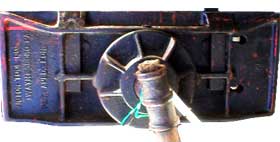
Victor Tool Co.
K1 Universal with short vise dogs, no cam, and
high-low ribbed collar.
Why include a Victor Tool Co. vise and where did it come from?
... This late comer to the Emmert Type Study is the earliest
known "K1" universal vise. The first photos were sent to me from a
fine gentleman in the highlands of Scotland. The
"New Improved" or "K1" vise that we all know and love was originally
patented by Victor R.
Koontz. The patent was filed
on Feb. 6, 1918 and granted on July 15, 1919. This rare and unique vise had
a short production run between these dates and was then changed to carry Emmert's
name.
Collar has 8
reinforcing ribs, half low or triangular shaped and half high fin, almost
rectangular shaped.
Front Jaw has Victor Tool Co. Waynesboro PA
and "PAT APLD FOR" (Logo4.5) or
"PATENTED" (Logo4.7) on left side and
K1 on the right. Extra bosses are cast to receive the bolts used to adjust
the taper adjustment.
Rear Jaw has no casting number.
Vise Dogs
are short on front and rear jaws and do not protrude
thru the lower jaw casting.
Taper Adjustment is accomplished by loosening the collar, adjusting 2
thumb screws and re-tightening the collar.
Hub is long hub with equal sided casting at split (Hub2).
Beam has slot on right side. Beam can be installed with slot on left
side.
Mounting Angle
Tilt Adj. Mechanism is a flat slotted bar (TA3).
This is a rare type.
Type U0.5 Photos

|
Type U1
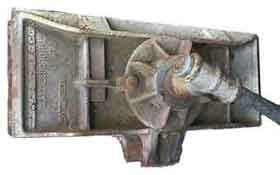
K1 Universal with short vise dogs, no cam, and
high-low ribbed collar.
Collar has
high-low ribbed collar. 8
reinforcing ribs or gussets, half triangular shaped (low) and half
almost rectangular shaped (high).
Front Jaw has Emmert Mfg. Co. Waynesboro PA
U.S.A. and Patented (Logo5) on left side and
K1 on the right. The drawing shows an extra horizontal rib extending to the
outer edge of the front jaw but actual vise does not. Extra bosses are cast
to receive the bolts used to adjust the taper adjustment.
Vertical rib near collar is missing.
Rear Jaw has no casting number.
Vise Dogs
are short on front and rear jaws and do not protrude
thru the lower jaw casting.
Taper Adjustment is not by use of a rotating cam. You adjust finger
screws on either side, just behind the collar.
Hub is long hub with equal sided casting at split (Hub2).
Beam has slot on right side. Beam can be installed with slot on left
side.
Mounting Angle
Tilt Adj. Mechanism is a flat slotted bar (TA3).
This is a rare type.
Type U1 Photos

|
Type U2
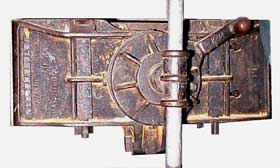
K1 Universal with long vise dogs, with cam added,
and high-low ribbed collar.
Collar has high-low ribbed collar. 8
reinforcing ribs or gussets, half triangular shaped (low) and half
almost rectangular shaped (high).
Front Jaw has Emmert Mfg. Co. Waynesboro PA
U.S.A. and Patented (Logo5) on left side and
K1 on the right. Vertical rib near collar is missing.
Rear Jaw has no casting number.
Vise Dogs 4 dogs, 2 flat top on rear jaw and 2 angled top on front
jaw. They are made of cast iron and break easily
Taper Adjustment now uses a cam with a handle and knob just behind
the collar. The knob is easily broken off.
Hub is long hub with equal sided casting at split (Hub2).
Beam has slot on right side. Beam can be installed with slot on left
side.
Mounting Angle
Tilt Adj. Mechanism is a flat slotted bar (TA3).
This is a uncommon type.
Type U2 Photos

|
Type U3
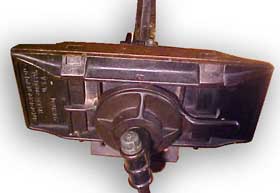
K1 Universal added vertical rib on front jaw behind
collar.
Collar has 4 reinforcing ribs, all triangular
shaped.
Front Jaw has Emmert Mfg. Co. Waynesboro PA
U.S.A. and Patented (Logo5) on left side and
K1 on the right. Vertical rib near collar added.
Rear Jaw
Vise Dogs
Taper Adjustment uses a cam with a handle and knob just behind the
collar.
Hub is long hub with equal sided casting at split (Hub2).
Beam has slot on right side. Beam can be installed with slot on left
side.
Mounting Angle
Tilt Adj. Mechanism is a flat slotted bar (TA3).
This is a uncommon type.
Type U3 Photos

|
Type U4
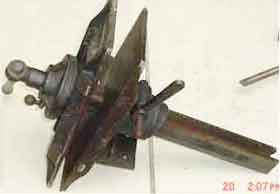
K1 Universal with 4 rib collar.
Collar has 4 reinforcing ribs, all triangular
shaped.
Front Jaw has Emmert Mfg. Co. Waynesboro PA
U.S.A. and Patented (Logo6) on left side and
K1 on the right. Vertical rib near collar added.
Rear Jaw
Vise Dogs
Taper Adjustment now uses a cam with a handle and knob just behind
the collar. The knob is easily broken off.
Hub changed to short hub with unequal sided casting at split (Hub3).
Beam has slot on right side. Beam can be installed with slot on left
side.
Mounting Angle
Tilt Adj. Mechanism is a flat slotted bar (TA3).
Type U4 Photos

|
Type U5
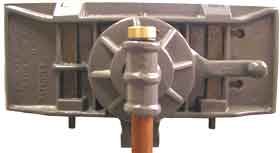
K1 Universal added extra reinforcement at base of
vise dogs and now has the standard 8 rib triangular fin collar.
Collar has 8 reinforcing ribs, all triangular
shaped.
Front Jaw has Emmert Mfg. Co. Waynesboro PA
U.S.A. and Patented (Logo6) on left side and
K1 on the right. Extra reinforcement at base of dogs added.
Rear Jaw
Vise Dogs
Taper Adjustment uses a cam with a handle and knob just behind the
collar and casting number K-14.
Hub is short hub with unequal sided casting at split (Hub3).
Beam has slot on right side. Beam can be installed with slot on left
side.
Mounting Angle
Tilt Adj. Mechanism is a flat slotted bar (TA3)
or flat solid bar (TA4).
This is the most common "New Improved" Universal Type.
Type U5 Photos

|
Type U6
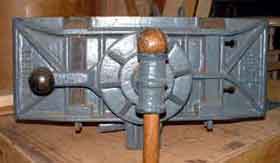
K1 Universal added extra V shaped reinforcement on
jaws and now has a plastic knob on the cam.
Collar has 8 reinforcing ribs, all triangular
shaped.
Front Jaw has Emmert Mfg Co on left side and
K-1 Waynesboro PA USA (Logo7) on the right.
Extra reinforcement at base of dogs. Extra V shaped ribs on jaws for more
reinforcement added.
Rear Jaw has casting number K-2 and V shaped reinforcing ribs.
Vise Dogs
Taper Adjustment uses a cam with a handle and a new plastic knob just
behind the collar and casting number K-14.
Hub is short hub with unequal sided casting at split (Hub3).
Beam has slot on right side. Beam can be installed with slot on left
side.
Mounting Angle
Tilt Adj. Mechanism is a solid flat bar (TA4).
Type U6 Photos

|

![]()